Trials evaluate relationship between aquafeed nitrogen levels and shrimp production
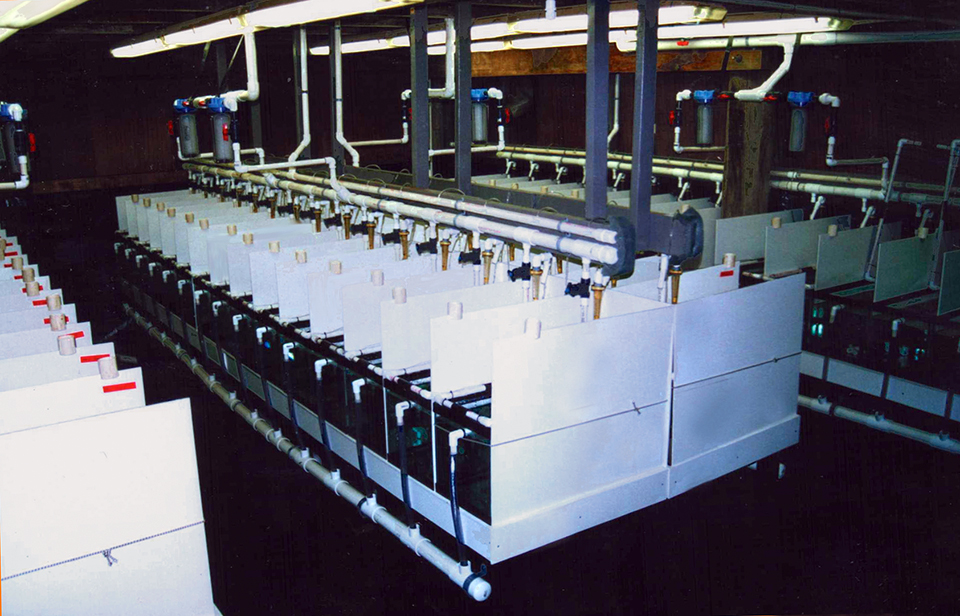
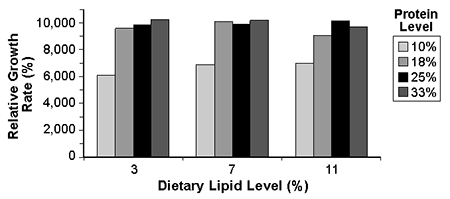
Protein is a major nutrient required for growth and one of the most expensive aquafeed components. Shrimp can readily utilize protein as an energy source, but this is neither economically efficient nor environmentally sound.
Aquafeeds have been identified as the major exogenous source of nitrogen in aquaculture effluents, so dietary protein should be optimized to obtain good survival and growth while minimizing nitrogen loading in the water. Two trials evaluated the relationship between aquafeed nitrogen levels and shrimp production in indoor and outdoor systems with zero water exchange.
Texas A & M trial
Experimental setup
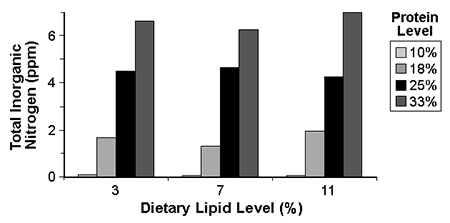
A 21-day experimental trial was conducted at the Shrimp Mariculture Research facility of Texas A&M University in Port Aransas, Texas, USA to test four dietary protein levels (10, 18, 25, and 33 percent) and three lipid levels (3, 7, and 11 percent). Postlarval (Litopenaeus vannamei) shrimp of 1.2 mg mean initial weight were stocked at 1.5 PL per liter in an indoor system with constant aeration and zero water exchange.
Water temperature and salinity were maintained at 27 to 29 degrees-C and 25 to 27 ppt, respectively. Total dissolved inorganic nitrogen (sum of total ammonia, nitrite, and nitrate) was measured at the end of the trial.
Survival and growth
With six replicates for each combination of protein and lipid level, mean postlarvae survival ranged 85.6 to 93.3 percent and was not significantly different among feeds. The growth of PL fed diets containing 10 percent
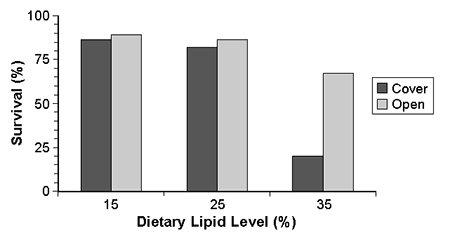
protein was significantly lower than for PL fed higher protein levels. No significant differences were found among the three higher protein levels. Growth was not significantly affected by dietary lipid level. The interaction between protein and lipid levels was not significant (Fig. 1).
Nitrogen levels
Average concentrations of total ammonia-N and nitrite-N ranged 0.05-2.20 (pH = 7.7-8.0) and from 0.01-2.44 milligrams per liter, respectively. The accumulation of dissolved total inorganic nitrogen (TIN) in the water significantly increased as dietary protein level increased (Fig. 2). Dietary lipid level did not affect TIN, and the interaction between these two factors was not significant.
Nitrogen assimilation
The low levels of TIN accumulation for the feed with 10 percent protein suggested that most of the dietary nitrogen was assimilated by the shrimp, with very little used as an energy source or mineralized.
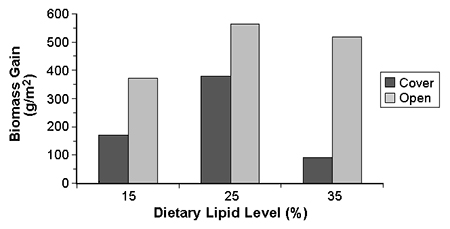
Since PL growth obtained with the 18 percent-protein feed was similar to that obtained with higher protein feeds, higher TIN levels in the water for feeds with 25 and 33 percent protein indicated an unnecessary breakdown of protein for energy and/or mineralization of the feed that could contribute to a negative environmental impact within the culture system.
Mass balance analysis of nitrogen (Table 1) indicated that as the dietary protein level decreased, nitrogen recovery on shrimp tissue increased. Consequently, less nitrogen ended up in the water.
Velasco, Mass balance analysis of nitrogen, Table 1
| Protein Level (%) | Feed (mg N) | Postlarvae (mg N) | Net Nitrogen Retention (%) |
|---|
Protein Level (%) | Feed (mg N) | Postlarvae (mg N) | Net Nitrogen Retention (%) |
|---|---|---|---|
| 10 | 64.2 | 55.8 | 85.5 |
| 18 | 115.5 | 82.7 | 70.9 |
| 25 | 160.5 | 78.3 | 48.2 |
| 33 | 211.8 | 79.2 | 37.0 |
Oceanic Institute trial
Experimental setup
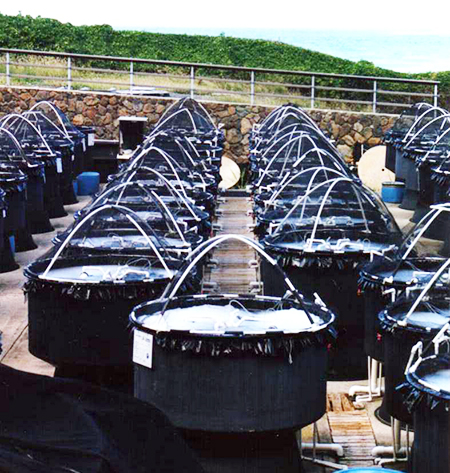
was higher in the tanks with higher natural productivity.
A 12-week trial at the Oceanic Institute in Waimanalo, Hawaii, USA tested dietary protein levels of 15, 25 and 35 percent. For the trial, L. vannamei juveniles of 1.0 gram mean initial weight were stocked at 50 shrimp per square meter in an aerated outdoor system without water exchange.
Water temperature was 26 to 28 degrees-C, and salinity was maintained at 32 to 35 ppt. Phytoplankton density was manipulated by covering some tanks with shade cloth, while others were left open to natural ambient light. Total dissolved inorganic nitrogen was measured at the end of the trial.
Survival and growth
Four treatments for each protein level were statistically analyzed to determine significant differences among treatments. Shrimp survival was significantly lower in the covered tanks with lower natural productivity, and for shrimp fed feed containing 35 percent crude protein (Fig. 3). Mean shrimp growth was higher in the open tanks with higher phytoplankton productivity, and for shrimp fed the 25 percent-protein diet (Fig. 4).
Phytoplankton and nitrogen
Phytoplankton density was reduced in the covered tanks, as indicated by chlorophyll-a determinations (values below 5 milligrams per liter). Dissolved TIN accumulation in the water significantly increased with increasing dietary protein level. TIN was higher in the tanks with reduced levels of phytoplankton (Fig. 5), indicating higher nitrogen uptake in the tanks with higher natural productivity.
Conclusion
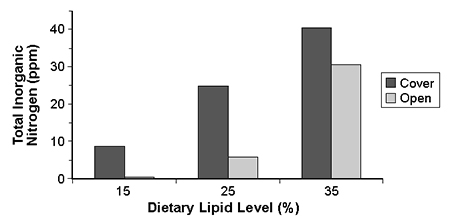
Results from this research in culture systems without water exchange indicated that dietary protein levels have a great impact on the dissolved inorganic nitrogen loading in water. Through appropriate nutritional strategies, both feed costs and potential environmental degradation of the culture system can be reduced without negatively impacting shrimp production.
(Editor’s Note: This article was originally published in the April 2002 print edition of the Global Aquaculture Advocate.)
Now that you've finished reading the article ...
… we hope you’ll consider supporting our mission to document the evolution of the global aquaculture industry and share our vast network of contributors’ expansive knowledge every week.
By becoming a Global Seafood Alliance member, you’re ensuring that all of the pre-competitive work we do through member benefits, resources and events can continue. Individual membership costs just $50 a year. GSA individual and corporate members receive complimentary access to a series of GOAL virtual events beginning in April. Join now.
Not a GSA member? Join us.
Authors
-
-
Lytha Conquest
The Oceanic Institute
41-202 Kalanianaole Highway
Waimanalo, Hawaii 96795 USA -
Addison Lawrence, Ph.D.
TAES Shrimp Mariculture Research
Texas A&M University System
Port Aransas, Texas, USA
Related Posts

Innovation & Investment
A review of unit processes in RAS systems
Since un-ionized ammonia-nitrogen and nitrite-nitrogen are toxic to most finfish, controlling their concentrations in culture tanks is a primary objective in the design of recirculating aquaculture systems.

Responsibility
Ammonia nitrogen dynamics in aquaculture
The major sources of ammonia in aquaculture ponds are fertilizers and feeds, and problems with high ammonia are most common in feed-based aquaculture.

Health & Welfare
Biofilter inoculation in recirculating aquaculture systems
Biological filters are essential parts of recirculating aquaculture systems that transform toxic fish compounds such as ammonium and nitrite into less-harmful nitrate. The authors tested the convenience and efficiency of three methods for the initial inoculation of aerobic biofilters.

Responsibility
Carbon-nitrogen balance impacts nitrogen removal
For aquaculture managers, it is important to control carbon type and carbon-nitrogen ratio by feed formulation, solids removal or addition of organic carbon.


